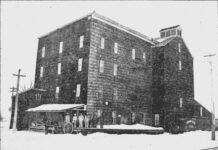When the Village of Kemptville, as it was then, established its own Hydro-Electric Commission in 1922 to connect with the Hydro-Electric Power Commission of Ontario (HEPCO), predecessor of Ontario Hydro services, the Bowens were ready to compete, planning a new expansion of their generating and distribution system, power fighting power in a fight to the death. But the terms laid down by the HEPCO, an Ontario government body, were strict, and Kemptville was not allowed the use of Bowen’s power generation services. No doubt, when local politician G. Howard Ferguson became Premier of Ontario in 1923, the pressure on Kemptville’s Hydro-Electric Commission to align with the government’s supply only increased.
Dan and Levi Bowen tried to continue their father’s very prosperous business, the Kemptville Milling Co. drew power from the Bowen’s electrical plant at Andrewsville, and the brothers had a long list of customers from Merrickville, through Burritts Rapids into Kemptville for the electricity supply. But in December 1923, they were ordered to remove the poles and wires running from Andrewsville in an agreement reached with Kemptville. The brothers seemingly tried to get around this deal by leasing the generating plant and the Kemptville mill to Dan Bowen. Since the agreement was with the Kemptville Milling Co., Dan simply kept the poles and wires in place. The local newspaper reported the resulting controversy on February 21, 1924:
“The dispute between the Corporation and Levi and Dan Bowen is the main topic of conversation in the village. Dan Bowen claims to have leased the power plant of the Kemptville Milling Co. and is using power, generated at Andrewsville, to operate his mill. The corporation claims that its agreement with the Kemptville Milling Co. included the dismantling of the sub station near the mill, which was not done. Monday morning Reeve McClenaghan, Constable Ault and electrician Williams proceeded to the mill and requested Bowen to close down the power so that the wires could be cut. This Bowen refused to do. The next step was an injunction to compel Bowen to cease operation by the use of power generated at Andrewsville. This injunction was granted by Judge Dowsley, at Brockville, and was served on both Levi and Dan Bowen. What the next act will be depends on how the injunction is observed.”
The injunction was, in fact, confirmed the following month, and was in place until the issue could be decided by the courts. But a further calamity befell the Bowens even as the trial was taking place in Brockville in May. Levi Bowen was taken ill suddenly during the hearing, and died the next day. To add to the dreadful series of events, the judge decided against Dan Bowen and the Kemptville Milling Co. In his judgment later in May. Dan had tried to show that his power lines ran along private property, and therefore the Village had no right to order their removal. However, it was found at trial that the wires crossed a number of Village streets, and were on Village property. The judge was quite dismissive of Dan Bowen’s arguments: “I am not leaving out of consideration the position assumed by defendant Bowen; but I cannot conclude it is borne out by the facts.”
Dan Bowen could not recover from the adverse decision and had sold the Andrewsville plant to Judson Watchorn before the end of the year. Watchorn used the plant to power his woolen mill in Merrickville and to supply electricity to just ten customers in Burritts Rapids. But even this became unviable in just a few years. In 1926, he contacted Premier Ferguson to see if HEPCO was interested in buying the Andrewsville plant from him. By then, he had 50 consumers in Burritts Rapids on 9 miles of line. Ferguson did inquire on Watchorn’s behalf, but the reply from Hydro experts was damning. There was nothing to attract HEPCO to the Andrewsville plant: it was outdated and underpowered, and Watchorn was left with Bowen’s legacy hanging heavily around his neck.
It was the end of the Bowen project, but not the end of the Kemptville Hydro Commission. Beginning with a warehouse and offices in the Fraser Block (now Rotary Park), the Commission moved into a specially-built extension to the Town Hall in 1937. In 1952, a new sub-station was built, and the Commission continued to operate for many more years.






